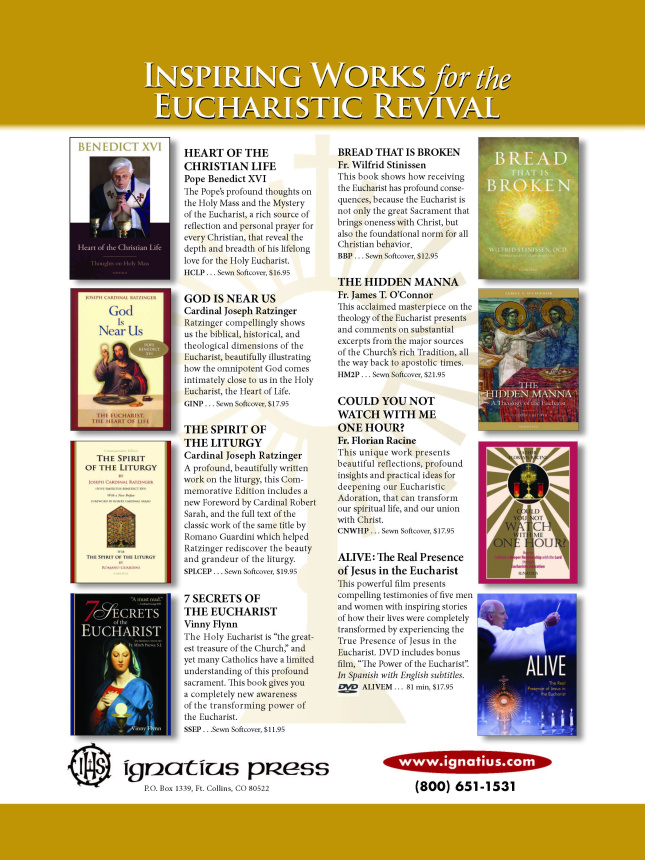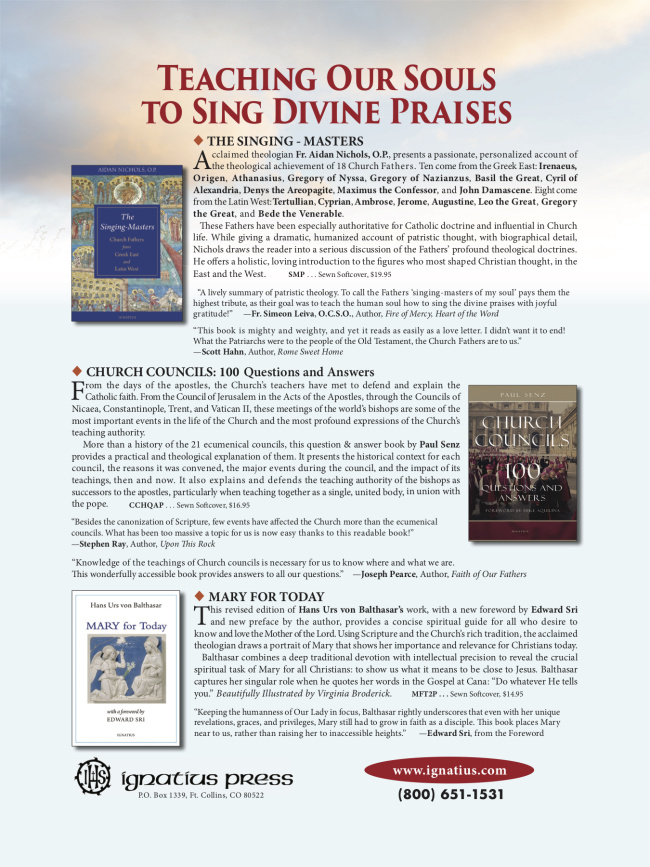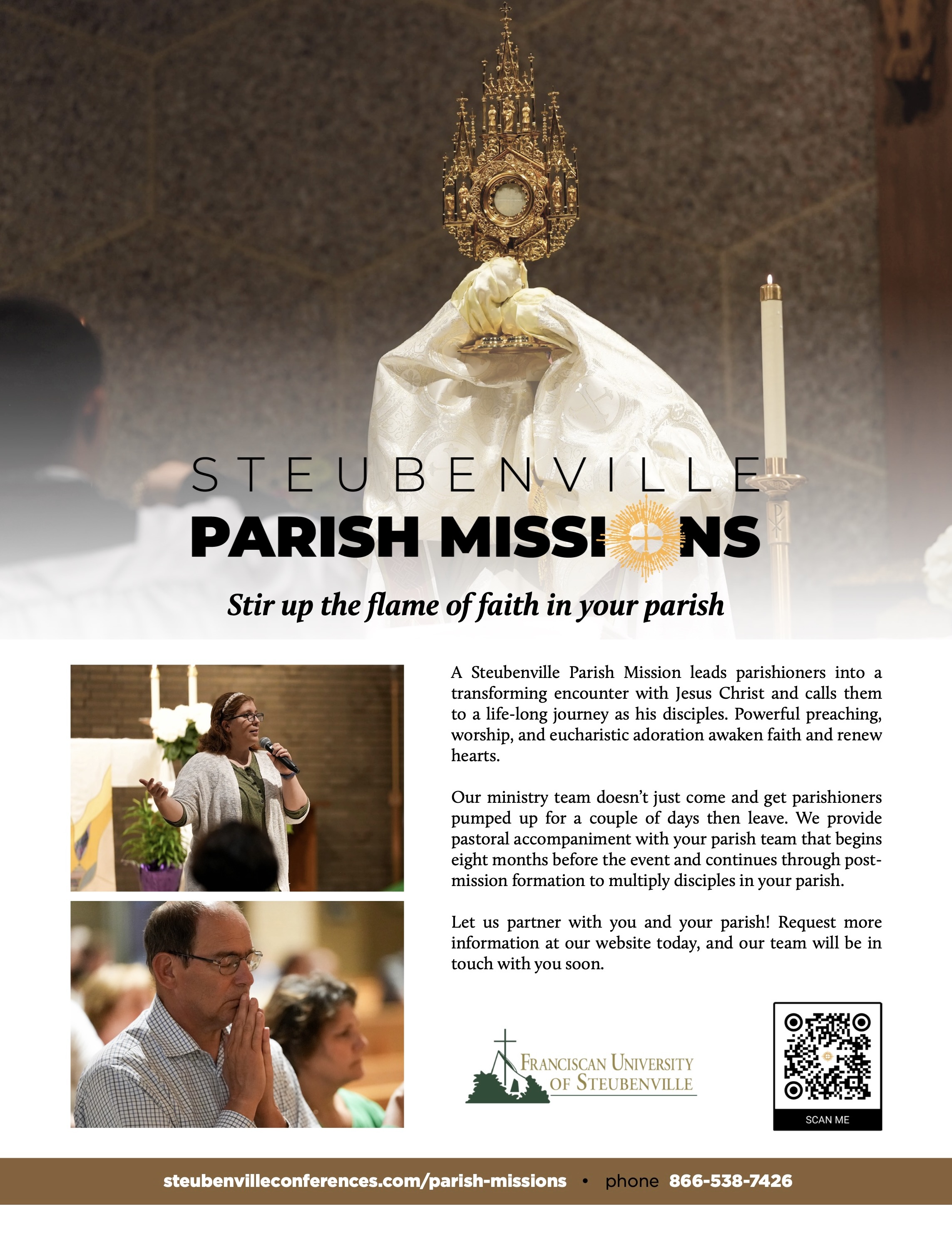AD: Inspiring Works for the Eucharistic Revival
This is a paid advertisement. To order these resources visit www.ignatius.com or call 800-651-1531.

AD: Is God Calling You to be a Spiritual Director?
To learn more: go to www.franciscan.edu/ssd or email [email protected] or call 740-283-6402.

The Spiritual Life: My Eucharistic Heart Attack
During the summer after my senior year in college in 1990, I experienced a return and deepening of my faith through the intercession of our Blessed Mother. The following January, as a 23-year-old seminarian, I began attending Mass every day. Today—32 years later—I have since gone to Mass and received Holy Communion over 10,000 times. Little by little, bit by bit, these 10,000 Communions have transformed me. Only in retrospect can I appreciate how much I needed to be transformed. Today, I am still a work in progress, but the Eucharist is the center of my life, the daily event around which I plan all things. It is probably not surprising, then, that most significant events in my life somehow seem to get intertwined with my relationship with Jesus in the Eucharist.
The fact that I had a heart attack in 2021 is nothing extraordinary. People have heart attacks all the time—over 800,000 in the US every year. What makes mine remarkable are the circumstances surrounding it.
On Ash Wednesday that year, I went away on a three-day silent retreat with a friend. I fast during Lent and find it helpful to get my Lent started at a place with perpetual Eucharistic adoration and no food temptations. While praying in front of the Blessed Sacrament, I often pray using symbolic images of my heart. Sometimes, I sit silently and ask our Lord to make my heart beat in sync with his. Sometimes, I ask him to heal it. Oftentimes, I imagine him reaching into my chest with both of his warm hands; together, they completely cover my heart. I then imagine him lifting it out of my body and bringing it toward his face, where he carefully blows on it with his warm breath, melting the ice and making it healthy again.
As I spent these days in prayer before the Blessed Sacrament, I received an unexpected and confusing thought during my prayer. While I prayed, I kept hearing that something was wrong with my heart. At first, I took this to mean a reference to my spiritual heart, so, naturally, I prayed for him to heal and transform it. But instead of a comforting, satisfying prayer, I felt increasingly agitated and unfulfilled. This was very frustrating, and it led me to question what this message meant. As we drove home on Saturday I shared this experience with my friend, and we concluded that I should schedule an appointment to get my heart checked out. At the time, I had no conscious awareness that anything might be wrong with it. Both of us agreed, however, that given my medical background—three bouts of cancer, two stem cell transplants, thirty lifetime surgeries, eighteen years of constant hospitalizations, etc.—it was probably a prudent thing to do.
Children's Catechesis: Teaching Children to Pray the Rosary
The Rosary is arguably the most widely prayed, most enduring devotion in Catholic history. Many have spoken about the power and beauty of the Rosary. Pope St. Pius X said, “Amidst all prayers, the Rosary is the most beautiful, the richest in graces, and the one that most pleases the Most Holy Virgin.”[1] October, the month of the Rosary, is the perfect time to introduce this beloved prayer to children and to encourage families to pray it together. The following are some recommendations for handing on this treasure of the Church.
- Remind Your Learners That Mary Is Our Mother
Motherhood is associated with a gentle, approachable strength. Many children feel most comfortable going to their mothers first when they are distressed or in trouble. When Jesus commends his mother to St. John at the Cross (Jn 19:26–27) he is, by extension, offering her as mother to the whole Church. And indeed, she is—for the Church is the Body of Christ and Mary is his mother. As our mother, the Blessed Virgin Mary wishes to encourage us, to protect us, to nurture us, and to teach us by always pointing us to her Son. Jesus is a good Son who loves and listens to his mother, so we can be certain that he hears whatever questions, worries, and problems we place at her feet. As Pope Leo XIII wrote, “How unerringly right, then, are Christian souls when they turn to Mary for help as though impelled by an instinct of nature, confidently sharing with her their future hopes and past achievements, their sorrows and joys, commending themselves like children to the care of a bountiful mother.”[2]
The Ministry Turnover Crisis: The Real Reason Parish Employees Are Burning Out
When you began working in the Church, how many friends did you have who were also serving in ministry? For me, it was several dozen. These youth ministers, Catholic school teachers, missionaries, and seminarians all began their work with so much zeal for the mission ahead of them.
Yet, nearly ten years later, I can count on one hand the number of those friends who are still involved in full-time ministry. Maybe you’ve experienced something similar. Most of these friends of mine devoted several years of their lives to a university formation and tens of thousands of dollars to be trained for effective ministry. Yet, when I talk with former parish employees, the majority of them have fled from parish ministry with plenty of hurt and a noticeable level of bitterness toward their experience.
There’s a few obvious reasons—salary limitations and simply discerning a different calling are common ones. However, I’ve experienced another much more troubling and harmful reason: too often, Catholic parishes are some of the most dysfunctional places to work.
I can say this confidently having worked as a leadership consultant with hundreds of pastors who have told me this themselves, as well as having been an employee at two parishes myself. While a Catholic parish office is meant to be a hub of prayer, evangelization, and true Christian friendship, it is far more common that it is a festering pool for mediocrity, confusion, and frustration. This dynamic begs the question: why? What is causing this exodus from parish ministry?
The biggest reason people leave employment in a parish is not because of issues with liturgy, music, programs, or hospitality—things that often get lots of attention. They leave because the organization is unhealthy and tolerates low standards. Without healthy and clear leadership, the best homily or most dynamic video series will only get you so far. This is completely counterintuitive to almost everything that we are taught in studies and formation! We spend hours and hours crafting plans and reading theology (which are extremely important), yet almost no time learning how to effectively lead the people entrusted to us. When I discuss this with pastors, I can’t tell you the number of them who have incredulously told me, “No one ever teaches you this in seminary!”
AD: Save the Dates: 2024 Steubenville Adult Conferences Announced!
Mark your calendar for the upcoming 2024 Steubenville Conferences for adults, held on our beautiful campus in Steubenville, OH. Registration will open in late January, 2024. NOTE: The St. John Bosco Conference for Evangelization & Catechesis is being postponed until summer of 2025 because of our involvement with the National Eucharistic Congress. Hope to see you there! Questions? Call 740-283-6315.
AD: Teaching Our Souls to Sing Divine Praises
This is a paid advertisement. To order these books, visit https://ignatius.com/ or call 800-651-1531.

Gossip is a Sickness, Prophecy is the Cure
“Have you heard something? Let it die with you. Be brave, it will not make you burst!” – Sirach 19:10
Light, Dew, and Fire: When Catechesis Is Attentive to the Holy Spirit

AD: Steubenville Parish Missions, Perfect for National Eucharistic Revival!
To learn more or to book a discovery meeting, go to steubenvilleconferences.com/parish-missions or call 866-538-7426, ext. 4.


